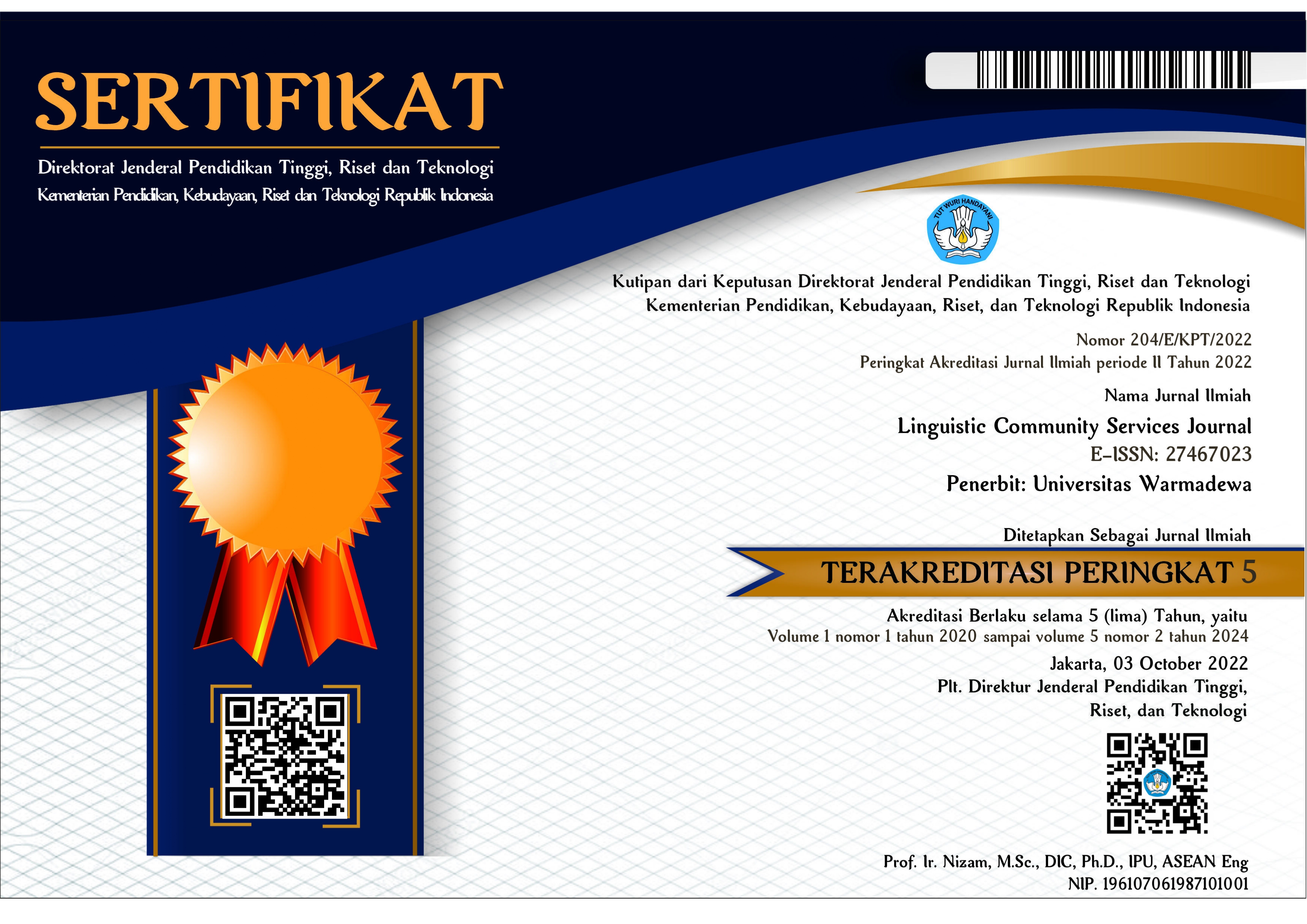Improving Listening Ability in English Learning for Students at SMP PGRI 3 Denpasar
Abstract
There are four common language skills that must be learned and studied continuously. One of the language skills that must be mastered by students is listening. By having based on ability, students will have the ability to express their thoughts and feelings correctly in the context of the situation needed and capture information with the speaker's intent, then respond to the information itself. A child learns a language through listening first. The process of listening, understanding meaning, imitating, and practicing language sound is repeated until the child speaks fluently. The same thing happens to adults when they learn a foreign language. This article describes the lack of listening in English for junior high school students and the appropriateness of teaching English to increase students' interest in developing listening skills. This may be because students' interest in listening skills is not good and the Extensive Listening approach is applied to improve listening skills, which is applied by the teacher in the learning process so that students do not practice listening skills in English. Based on this situation, the aim of this activity is to help build students' interest in improving English listening skills and through an extensive listening and application approach to teaching listening skills to junior high school students. In the process of listening there are five components, namely paying attention, understanding, remembering, and providing feedback or feedback. The object of this PKM activity is SMP PGRI 3 Denpasar, especially for class VIII students. The results of the research in this activity indicate that students are able to master the five components that have been applied in the teaching process of the Extensive Listening approach that is applied in improving students' listening skills and are able to pay attention, and understand, remember, and respond. Thus, in this case, the implementation is carried out with this focus so that learning outcomes can be optimal.
References
Anthony, E. M. (1993). Approach, method, and technique. English language teaching. New York: Oxford University Press.
Atkinson, Rita L., D. (2000). Hilgard’s Introduction to Psychology. (13 th ed.). (Smith, Ed.). CarolynD: HarcourtCollege Publishers.
Busri, H., Badrih, M., Sofiah, U., Farizi, M. F. Al, Rahmania, A., Aulia, A., … Nurhidayati, T. (2020). LINGUISTIK TERAPAN Konsep Pembelajaran dan Penelitian Linguistik Mutakhir. Malang : Literasi Nusantara.
Ekasani, K. A., Lestari, D., Laba, I. N., Adnyani, K. E. K., Tjendani, E. N., Astawa, I. G., … Setiawan, I. (2020). Linguistik Terapan dalam Berbagai Perspektif. Yaguwipa : Denpasar.
Hasyuni. (2006). The Students’ Preferred Activities for English Listening Classes (A Survey Conducted to the Second and Fourth Semester Students of English Department of FKIP Academic Year 2005/2006). Unpublished Thesis of Teacher Training and Educati. Bengkulu: Universitas Bengkulu.
Hornby, A. S. (1990). Oxford Advanced Learner’s Dictionary of Current English. Oxford: Oxford University Press.
Mee, M. Y. (1990). Teaching Listening: An Overview. The English Teacher, XIX.
Richards, J. C. & Renandya, W. A. (2022). Methodology in language teaching: An anthology of current practice. Cambridge: Cambridge University Press.
Rivers, W. M. and M. S. T. (1971). A Practical Guide To The Teaching Of English As A Second Language. New York: Oxford University Press.
Bridgeman, B., & Morgan, R. (1996). Success in college for students with discrepancies between performance on multiple-choice and essay tests. Journal of Educational Psychology, 88(2), 333–340.
Copyright (c) 2022 Linguistic Community Services Journal

This work is licensed under a Creative Commons Attribution-ShareAlike 4.0 International License.
This journal provides immediate open access to its content on the principle that making research freely available to the public supports a greater global exchange of knowledge.
All articles published Open Access will be immediately and permanently free for everyone to read and download. We are continuously working with our author communities to select the best choice of license options, currently being defined for this journal as follows: Creative Commons-Non Ceomercial-Attribution-ShareAlike (CC BY-NC-SA)
 Abstract viewed = 258 times
Abstract viewed = 258 times
 PDF downloaded = 874 times
PDF downloaded = 874 times













